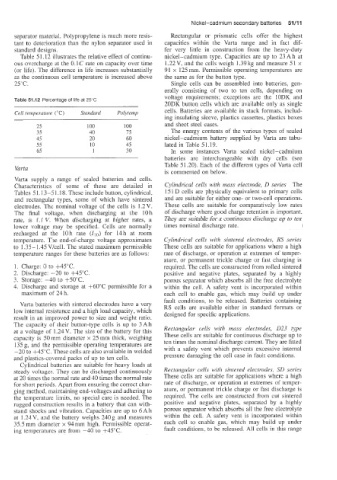Page 567 - Battery Reference Book
P. 567
Nickel-cadmium secondary batteries 51/11
separator material. Polypropylene is much more resis- Rectangular or prismatic cells offer the highest
tant to deterioration than the nylon separator used in capacities within the Varta range and in fact dif-
standard designs. fer very little in construction from the heavy-duty
Table 5 1.12 illustrates the relative effect of continu- nickel-cadmium type. Capacities are up to 23Ah at
ous overcharge at the 0.1 C rate on capacity over time 1.22 V, and the cells weigh 1.39 kg and measure 51 x
(or life). The difference in life increases substantially 91 x 125mm. Permissible operating temperatures are
as the continuous cell temperature is increased above the same as for the button type.
25°C. Single cells can be assembled into batteries, gen-
erally consisting of two to ten cells, depending on
voltage requirements; exceptions are the l0DK and
Table 51.62 Percentage of life at 25°C
20DK button cells which are available only as single
Cell temperature ("C) Standard Polytemp cells. Batteries are available in stack formats, includ-
ing insulating sleeve, plastics cassettes, plastics boxes
25 100 100 and sheet steel cases.
35 40 I5 The energy contents of the various types of sealed
45 20 60 nickel-cadmium battery supplied by Varta are tabu-
55 10 45 lated in Table 51.19.
65 1 30 In some instances Varta sealed nickel-cadmium
batteries are interchangeable with dry cells (see
Table 51.20). Each of the different types of Varta cell
Varta
is commented on below.
Varta supply a range of sealed batteries and cells.
Characteristics of some of these are detailed in Cylindrical cells with mass electrode, D series The
Tables 5 1.13 -5 1.18. These include button, cylindrical, 151 D cells are physically equivalent to primary cells
and rectangular types, some of which have sintered and are suitable for either one- or two-cell operations.
electrodes. The nominal voltage of the cells is 1.2 V. These cells are suitable for comparatively low rates
The final voltage, when discharging at the 10h of discharge where good charge retention is important.
rate, is 1.1 V. When discharging at higher rates, a They are suitable for a continuous discharge up to ten
lower voltage may be specified. Cells are normally times nominal discharge rate.
recharged at the 10h rate (110) for 14h at room
temperature. The end-of-charge voltage approximates Cylindrical cells with sintered electrodes, RS series
to 1.35- 1.45 Vkell. The stated maximum pemssible These cells are suitable for applications where a high
temperature ranges for these batteries are as follows: rate of discharge, or operation at extremes of temper-
ature, or permanent trickle charge or fast charging is
1. Chaxge: 0 to +45"C. required. The cells are constructed from rolled sintered
2. Discharge: -20 to +45"C. positive and negative plates, separated by a highly
3. Storage: -40 to +50"C. porous separator which absorbs all the free electrolyte
4. Discharge and storage at +60"C permissible for a within the cell. A safety vent is incorporated within
maximum of 24 h. each cell to enable gas, which may build up under
fault conditions, to be released. Batteries containing
Varta batteries with sintered electrodes have a very RS cells are available either in standard formats or
low internal resistance and a high load capacity, which designed for specific applications.
result in an improved power to size and weight ratio.
The capacity of their button-type cells is up to 3 Ah
at a voltage of 1.24 V. The size of the battery for this Rectangular cells with mass electrodes, 023 type
capacity is 50 mm diameter x 25 mm thick, weighing These cells are suitable for continuous discharge up to
135 g, and the permissible operating temperatures are ten times the nominal discharge current. They are fitted
-20 to 145°C. These cells are also available in welded with a safety vent which prevents excessive internal
and plastics-covered packs of up to ten cells. pressure damaging the cell case in fault conditions.
Cylindrical batteries are suitable for heavy loads at
steady voltages. They can be discharged continuously Rectangular cells with sintered electrodes, SD series
at 20 times the normal rate and 40 times the normal rate These cells are suitable for applications where a high
for short periods. Apart from ensuring the correct char- rate of discharge, or operation at extremes of temper-
ging method, maintaining end-voltages and adhering to ature, or permanent trickle charge or fast discharge is
the temperature limits, no special care is needed. The required. The cells are constructed from cut sintered
rugged construction results in a battery that can with- positive and negative plates, separated by a highly
stand shocks and vibration. Capacities are up to 6 Ah porous separator which absorbs all the free electrolyte
at 1.24V, aad the battery weighs 240g and measures within the cell. A safety vent is incorporated within
35.5 mm diameter x 94 mm high. Permissible operat- each cell to enable gas, which may build up under
ing temperatures are from -40 to +45"C. fault conditions, to be released. All cells in this range

